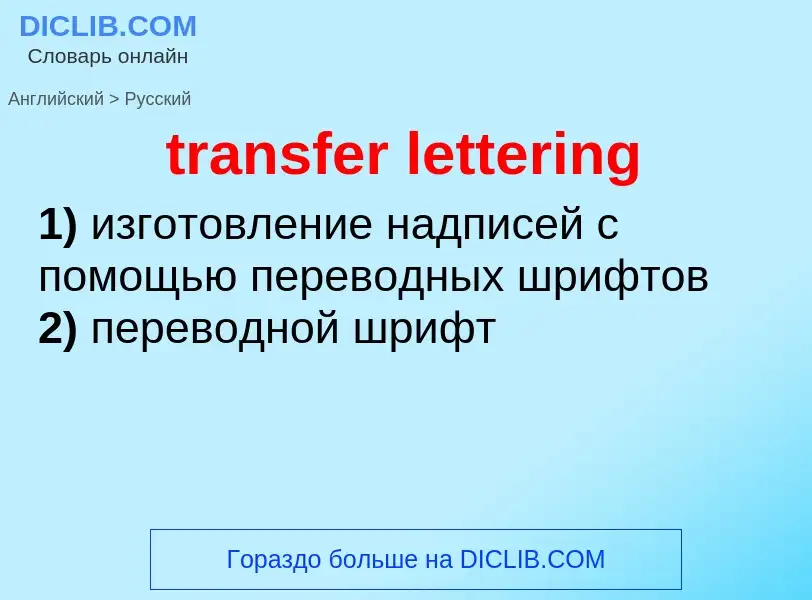transfer lettering - ترجمة إلى الروسية
تعريف
ويكيبيديا
Dry transfers (also called rub-ons or rubdowns) are decals that can be applied without the use of water or other solvent. The decal itself is on a backing material such as paper or plastic sheeting much like a transparency. The dry transfer is placed in the desired location with the backing side up. The decal is then applied by burnishing the backing with a stylus or similar object such as a ballpoint pen. The contact side of the decal includes a pressure-sensitive adhesive; the combination of heat and pressure causes the decal to stick more strongly to the new surface than to the backing. When the backing is removed, the decal remains. This allows for ink only where needed even if the pattern is delicate, because the backing supports the decal while it is being applied.
Dry transfers are used in manual technical drawing when standard graphic elements such as title blocks, forms, patterned lines, shading, piping or electronic schematic symbols need to be repetitively used. Use of a dry transfer reduces drawing time and standardizes appearance. Dry transfer lettering such as Letraset brand is used where hand-drawn lettering is laborious to apply. From the 1960s to the 1980s, dry transfers featuring action scenes were a popular children's pastime.


![In 1996, Dutchman [[Edgar Davids]] was the first high-profile player to move on a free transfer via the [[Bosman ruling]]. In 1996, Dutchman [[Edgar Davids]] was the first high-profile player to move on a free transfer via the [[Bosman ruling]].](https://commons.wikimedia.org/wiki/Special:FilePath/Edgar Davids.jpg?width=200)
![[[John Hartson]] failed medical tests which led to the shelving of three potential transfers in 2000. [[John Hartson]] failed medical tests which led to the shelving of three potential transfers in 2000.](https://commons.wikimedia.org/wiki/Special:FilePath/Hartson, John.jpg?width=200)
![Bayern Munich]] from [[RB Leipzig]] for a world record-breaking fee of €25 Million in 2021. Bayern Munich]] from [[RB Leipzig]] for a world record-breaking fee of €25 Million in 2021.](https://commons.wikimedia.org/wiki/Special:FilePath/Julian Nagelsmann 2020.jpg?width=200)
![[[Neymar]] (right) and [[Kylian Mbappé]] (left) are the two most expensive association football transfers. [[Neymar]] (right) and [[Kylian Mbappé]] (left) are the two most expensive association football transfers.](https://commons.wikimedia.org/wiki/Special:FilePath/Mbappe Messi Neymar.jpg?width=200)
![Barcelona]] in 2013 became the subject of investigation. Barcelona]] in 2013 became the subject of investigation.](https://commons.wikimedia.org/wiki/Special:FilePath/Neymar Barcelona presentation 1.jpg?width=200)

![[[Zinedine Zidane]] was the most expensive player in the world for eight years. [[Zinedine Zidane]] was the most expensive player in the world for eight years.](https://commons.wikimedia.org/wiki/Special:FilePath/Zidane Zizu.jpg?width=200)